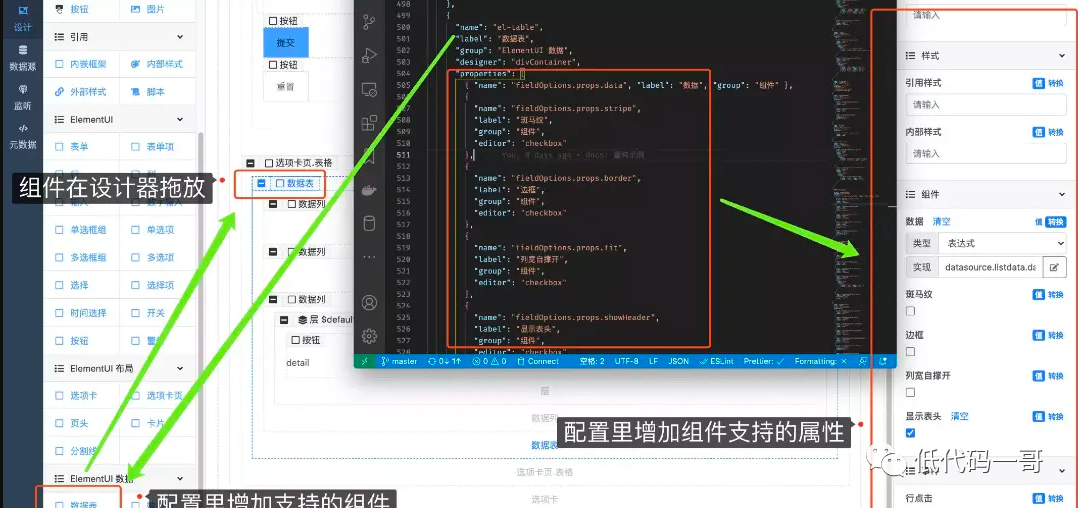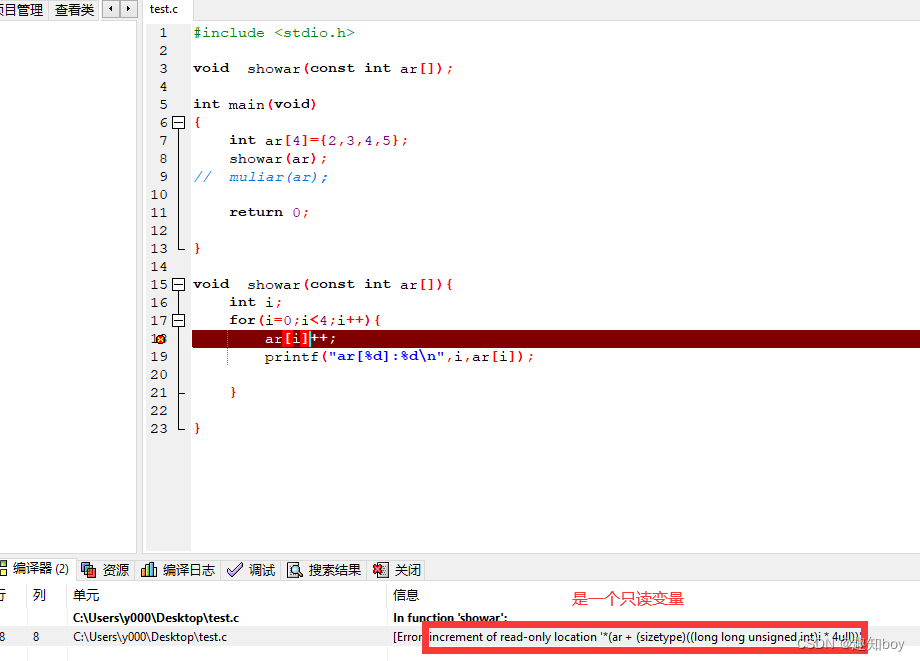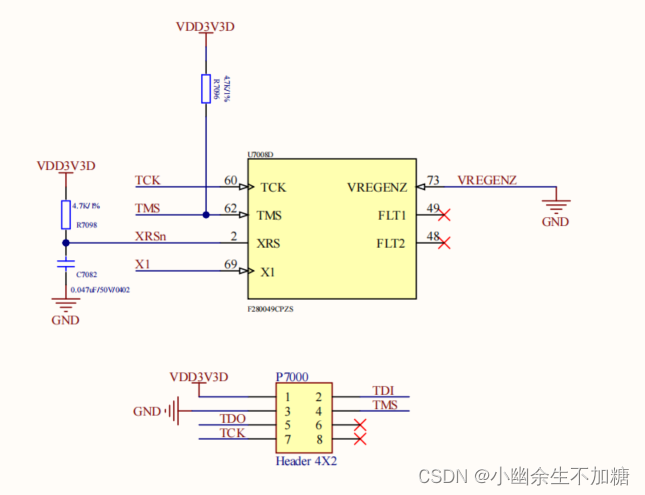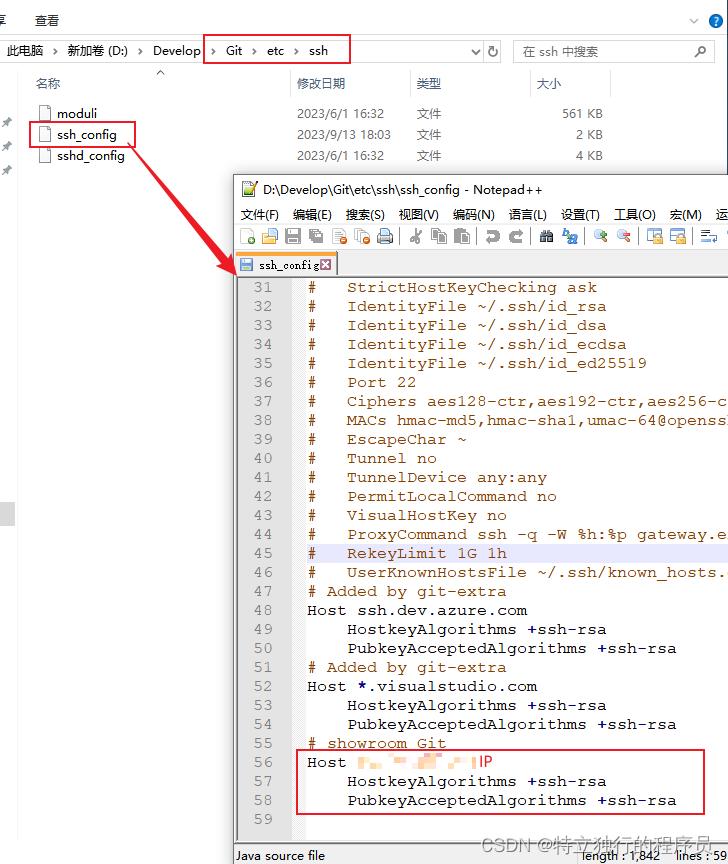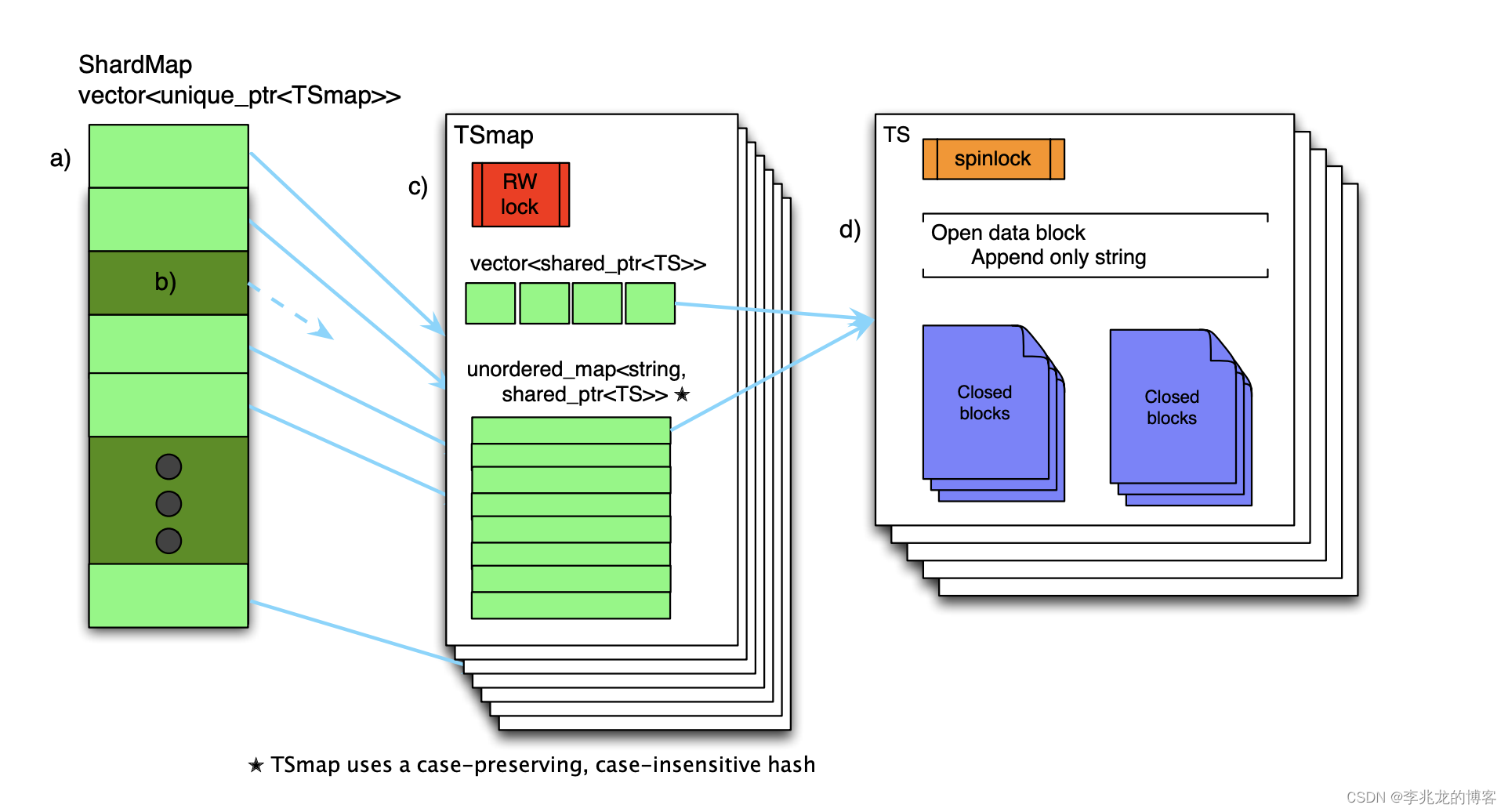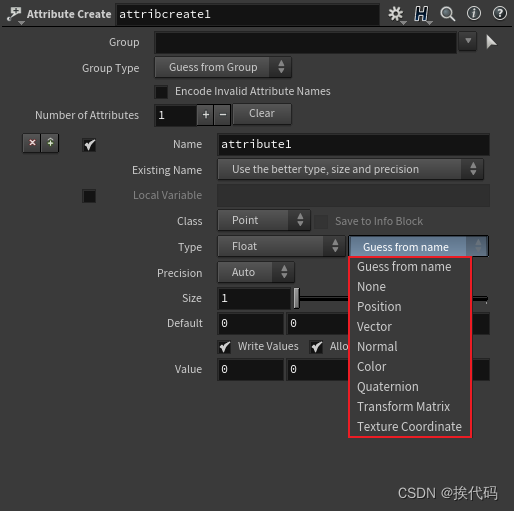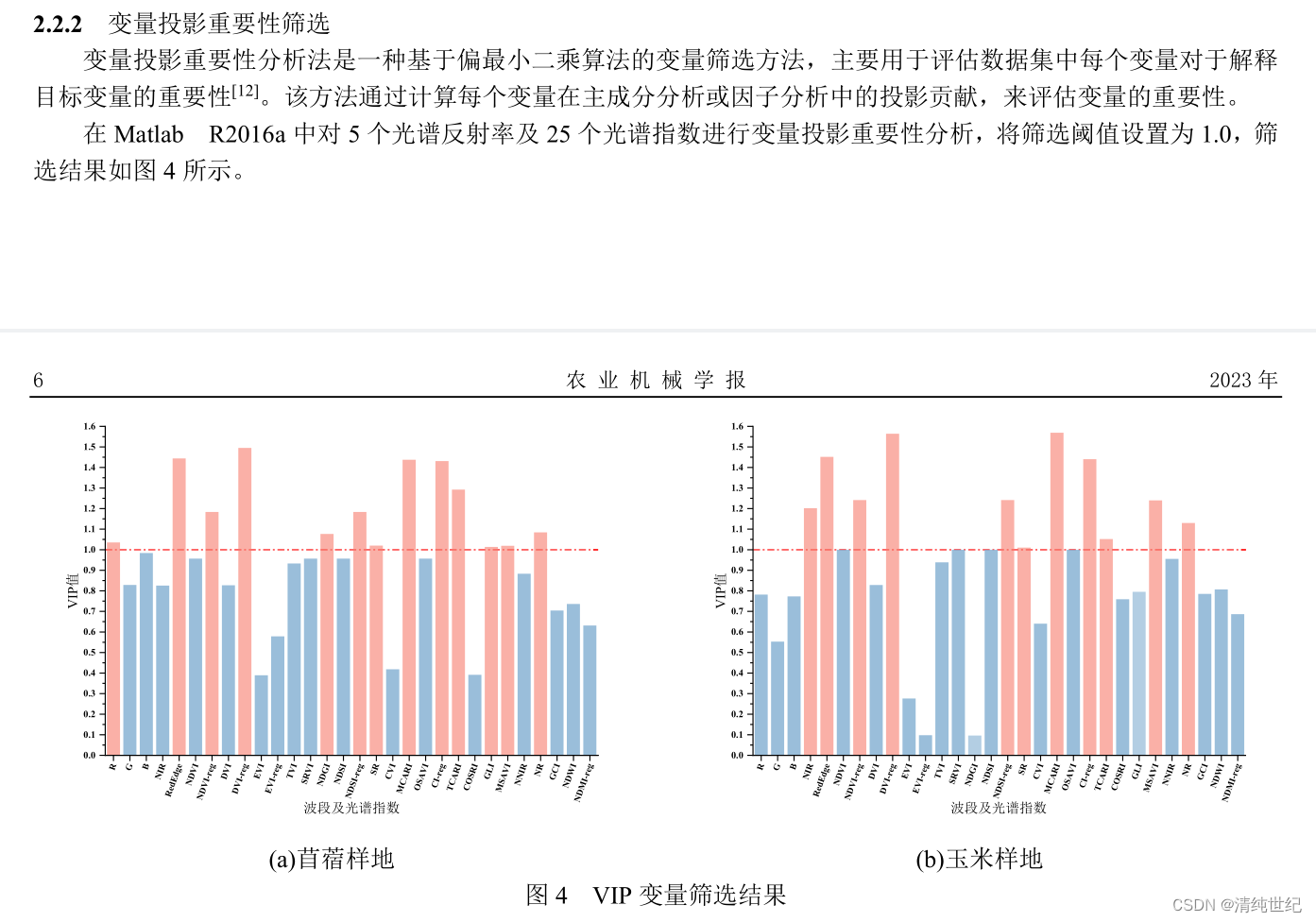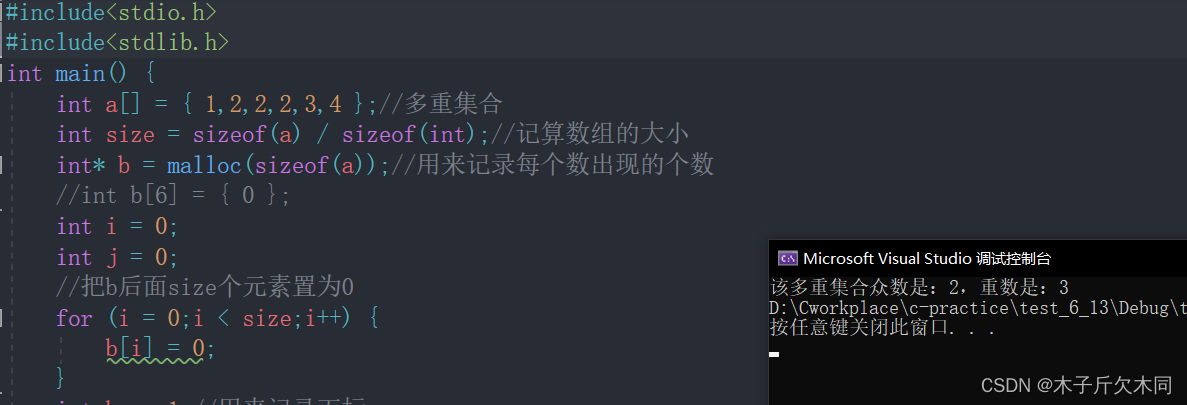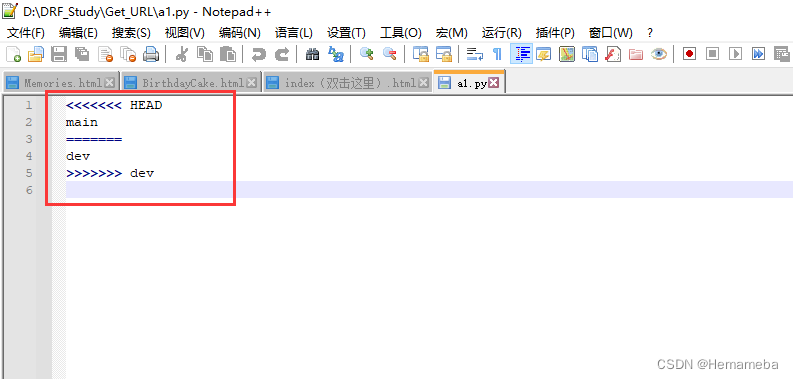引言
今天我们来实现ESIM文本匹配,这是一个典型的交互型文本匹配方式,也是近期第一个测试集准确率超过80%的模型。
我们来看下是如何实现的。
模型架构
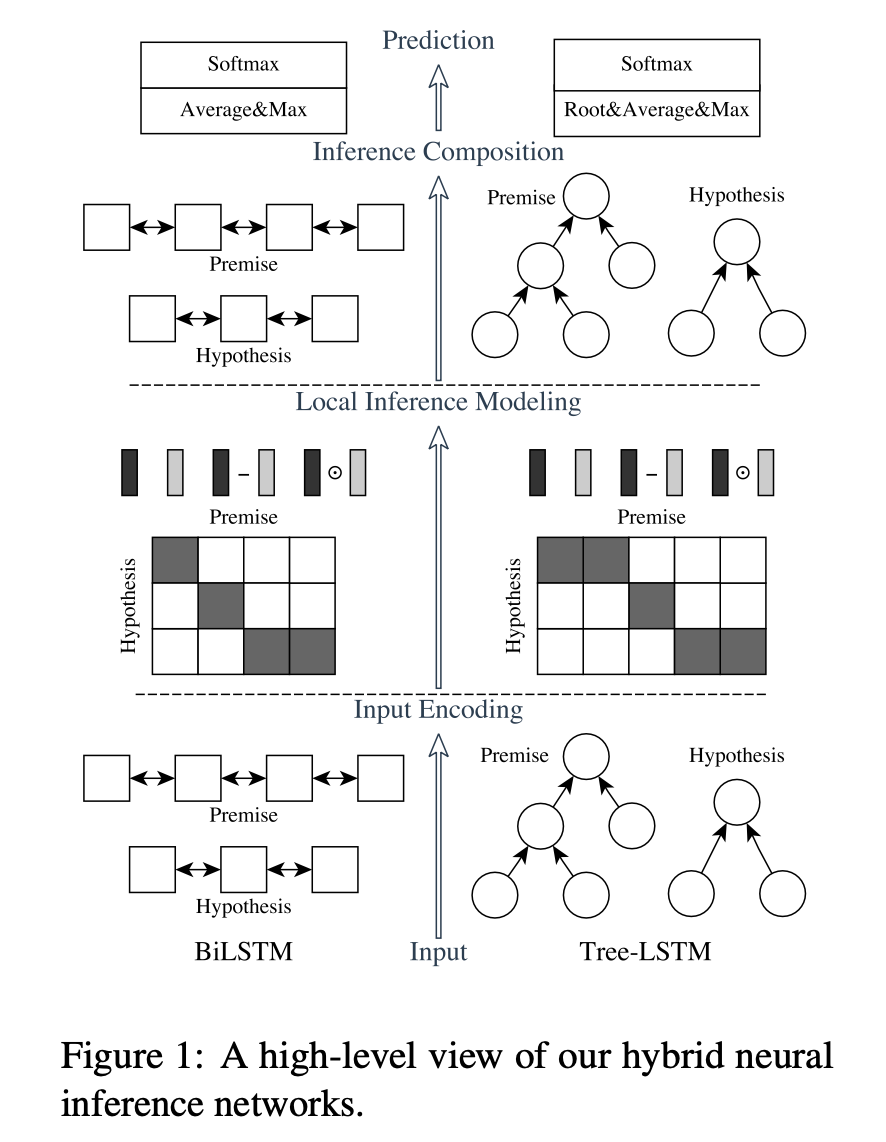
我们主要实现左边的ESIM网络。
从下往上看,分别是
- 输入编码层(Input Ecoding)
对前提和假设进行编码
把语句中的单词转换为词向量,得到一个向量序列
把两句话的向量序列分别送入各自的Bi-LSTM网络进行语义特征抽取 - 局部推理建模层(Local Inference Modeling)
就是注意力层
通过注意力层捕获LSTM输出向量间的局部特征
然后通过元素级方法构造了一些特征 - 推理组合层(Inference Composition)
和输入编码层一样,也是Bi-LSTM
在捕获了文本间的注意力特征后,进一步做的融合/提取语义特征工作 - 预测层(Prediction)
拼接平均池化和最大池化后得到的向量
接Softmax进行分类
模型实现
class ESIM(nn.Module):
def __init__(
self,
vocab_size: int,
embedding_size: int,
hidden_size: int,
num_classes: int,
lstm_dropout: float = 0.1,
dropout: float = 0.5,
) -> None:
"""_summary_
Args:
vocab_size (int): the size of the Vocabulary
embedding_size (int): the size of each embedding vector
hidden_size (int): the size of the hidden layer
num_classes (int): the output size
lstm_dropout (float, optional): dropout ratio in lstm layer. Defaults to 0.1.
dropout (float, optional): dropout ratio in linear layer. Defaults to 0.5.
"""
super().__init__()
self.embedding = nn.Embedding(vocab_size, embedding_size)
# lstm for input embedding
self.lstm_a = nn.LSTM(
hidden_size,
hidden_size,
batch_first=True,
bidirectional=True,
dropout=lstm_dropout,
)
self.lstm_b = nn.LSTM(
hidden_size,
hidden_size,
batch_first=True,
bidirectional=True,
dropout=lstm_dropout,
)
首先有一个嵌入层,然后对于输入的两个句子分别有一个Bi-LSTM。
然后定义推理组合层:
# lstm for augment inference vector
self.lstm_v_a = nn.LSTM(
8 * hidden_size,
hidden_size,
batch_first=True,
bidirectional=True,
dropout=lstm_dropout,
)
self.lstm_v_b = nn.LSTM(
8 * hidden_size,
hidden_size,
batch_first=True,
bidirectional=True,
dropout=lstm_dropout,
)
完了就是最后的预测层,这里是一个多层前馈网络:
self.predict = nn.Sequential(
nn.Linear(8 * hidden_size, 2 * hidden_size),
nn.ReLU(),
nn.Dropout(dropout),
nn.Linear(2 * hidden_size, hidden_size),
nn.ReLU(),
nn.Dropout(dropout),
nn.Linear(hidden_size, num_classes),
)
初始化函数的完整实现为:
class ESIM(nn.Module):
def __init__(
self,
vocab_size: int,
embedding_size: int,
hidden_size: int,
num_classes: int,
lstm_dropout: float = 0.1,
dropout: float = 0.5,
) -> None:
"""_summary_
Args:
vocab_size (int): the size of the Vocabulary
embedding_size (int): the size of each embedding vector
hidden_size (int): the size of the hidden layer
num_classes (int): the output size
lstm_dropout (float, optional): dropout ratio in lstm layer. Defaults to 0.1.
dropout (float, optional): dropout ratio in linear layer. Defaults to 0.5.
"""
super().__init__()
self.embedding = nn.Embedding(vocab_size, embedding_size)
# lstm for input embedding
self.lstm_a = nn.LSTM(
hidden_size,
hidden_size,
batch_first=True,
bidirectional=True,
dropout=lstm_dropout,
)
self.lstm_b = nn.LSTM(
hidden_size,
hidden_size,
batch_first=True,
bidirectional=True,
dropout=lstm_dropout,
)
# lstm for augment inference vector
self.lstm_v_a = nn.LSTM(
8 * hidden_size,
hidden_size,
batch_first=True,
bidirectional=True,
dropout=lstm_dropout,
)
self.lstm_v_b = nn.LSTM(
8 * hidden_size,
hidden_size,
batch_first=True,
bidirectional=True,
dropout=lstm_dropout,
)
self.predict = nn.Sequential(
nn.Linear(8 * hidden_size, 2 * hidden_size),
nn.ReLU(),
nn.Dropout(dropout),
nn.Linear(2 * hidden_size, hidden_size),
nn.ReLU(),
nn.Dropout(dropout),
nn.Linear(hidden_size, num_classes),
)
使用ReLU激活函数,在激活函数后都有一个Dropout。
重点是forward方法:
def forward(self, a: torch.Tensor, b: torch.Tensor) -> torch.Tensor:
"""
Args:
a (torch.Tensor): input sequence a with shape (batch_size, a_seq_len)
b (torch.Tensor): input sequence b with shape (batch_size, b_seq_len)
Returns:
torch.Tensor:
"""
# a (batch_size, a_seq_len, embedding_size)
a_embed = self.embedding(a)
# b (batch_size, b_seq_len, embedding_size)
b_embed = self.embedding(b)
# a_bar (batch_size, a_seq_len, 2 * hidden_size)
a_bar, _ = self.lstm_a(a_embed)
# b_bar (batch_size, b_seq_len, 2 * hidden_size)
b_bar, _ = self.lstm_b(b_embed)
# score (batch_size, a_seq_len, b_seq_len)
score = torch.matmul(a_bar, b_bar.permute(0, 2, 1))
# softmax (batch_size, a_seq_len, b_seq_len) x (batch_size, b_seq_len, 2 * hidden_size)
# a_tilde (batch_size, a_seq_len, 2 * hidden_size)
a_tilde = torch.matmul(torch.softmax(score, dim=2), b_bar)
# permute (batch_size, b_seq_len, a_seq_len) x (batch_size, a_seq_len, 2 * hidden_size)
# b_tilde (batch_size, b_seq_len, 2 * hidden_size)
b_tilde = torch.matmul(torch.softmax(score, dim=1).permute(0, 2, 1), a_bar)
# m_a (batch_size, a_seq_len, 8 * hidden_size)
m_a = torch.cat([a_bar, a_tilde, a_bar - a_tilde, a_bar * a_tilde], dim=-1)
# m_b (batch_size, b_seq_len, 8 * hidden_size)
m_b = torch.cat([b_bar, b_tilde, b_bar - b_tilde, b_bar * b_tilde], dim=-1)
# v_a (batch_size, a_seq_len, 2 * hidden_size)
v_a, _ = self.lstm_v_a(m_a)
# v_b (batch_size, b_seq_len, 2 * hidden_size)
v_b, _ = self.lstm_v_b(m_b)
# (batch_size, 2 * hidden_size)
avg_a = torch.mean(v_a, dim=1)
avg_b = torch.mean(v_b, dim=1)
max_a, _ = torch.max(v_a, dim=1)
max_b, _ = torch.max(v_b, dim=1)
# (batch_size, 8 * hidden_size)
v = torch.cat([avg_a, max_a, avg_b, max_b], dim=-1)
return self.predict(v)
标注出每个向量的维度就挺好理解的。
首先分别为两个输入得到嵌入向量;
其次喂给各自的LSTM层,得到每个时间步的输出,注意由于是双向LSTM,因此最后的维度是2 * hidden_size;
接着对它两计算注意力分数score (batch_size, a_seq_len, b_seq_len);
然后分别计算a对b和b对a的注意力,这里要注意softmax中dim的维度。在计算a的注意力输出时,是利用b每个输入的加权和,所以softmax(score, dim=2)在b_seq_len维度上间求和;
然后是增强的局部推理,差、乘各种拼接,得到一个8 * hidden_size的维度,所以lstm_v_a的输入维度是8 * hidden_size;
接下来就是对得到的a和b进行平均池化和最大池化,然后把它们拼接起来,也得到了8 * hidden_size的一个维度;
最后经过我们的预测层,多层前馈网络,进行了一些非线性变换后变成了输出维度大小,比较最后一个维度的值哪个大当成对哪个类的一个预测;
数据准备
和前面几篇几乎一样,这里直接贴代码:
from collections import defaultdict
from tqdm import tqdm
import numpy as np
import json
from torch.utils.data import Dataset
import pandas as pd
from typing import Tuple
UNK_TOKEN = "<UNK>"
PAD_TOKEN = "<PAD>"
class Vocabulary:
"""Class to process text and extract vocabulary for mapping"""
def __init__(self, token_to_idx: dict = None, tokens: list[str] = None) -> None:
"""
Args:
token_to_idx (dict, optional): a pre-existing map of tokens to indices. Defaults to None.
tokens (list[str], optional): a list of unique tokens with no duplicates. Defaults to None.
"""
assert any(
[tokens, token_to_idx]
), "At least one of these parameters should be set as not None."
if token_to_idx:
self._token_to_idx = token_to_idx
else:
self._token_to_idx = {}
if PAD_TOKEN not in tokens:
tokens = [PAD_TOKEN] + tokens
for idx, token in enumerate(tokens):
self._token_to_idx[token] = idx
self._idx_to_token = {idx: token for token, idx in self._token_to_idx.items()}
self.unk_index = self._token_to_idx[UNK_TOKEN]
self.pad_index = self._token_to_idx[PAD_TOKEN]
@classmethod
def build(
cls,
sentences: list[list[str]],
min_freq: int = 2,
reserved_tokens: list[str] = None,
) -> "Vocabulary":
"""Construct the Vocabulary from sentences
Args:
sentences (list[list[str]]): a list of tokenized sequences
min_freq (int, optional): the minimum word frequency to be saved. Defaults to 2.
reserved_tokens (list[str], optional): the reserved tokens to add into the Vocabulary. Defaults to None.
Returns:
Vocabulary: a Vocubulary instane
"""
token_freqs = defaultdict(int)
for sentence in tqdm(sentences):
for token in sentence:
token_freqs[token] += 1
unique_tokens = (reserved_tokens if reserved_tokens else []) + [UNK_TOKEN]
unique_tokens += [
token
for token, freq in token_freqs.items()
if freq >= min_freq and token != UNK_TOKEN
]
return cls(tokens=unique_tokens)
def __len__(self) -> int:
return len(self._idx_to_token)
def __getitem__(self, tokens: list[str] | str) -> list[int] | int:
"""Retrieve the indices associated with the tokens or the index with the single token
Args:
tokens (list[str] | str): a list of tokens or single token
Returns:
list[int] | int: the indices or the single index
"""
if not isinstance(tokens, (list, tuple)):
return self._token_to_idx.get(tokens, self.unk_index)
return [self.__getitem__(token) for token in tokens]
def lookup_token(self, indices: list[int] | int) -> list[str] | str:
"""Retrive the tokens associated with the indices or the token with the single index
Args:
indices (list[int] | int): a list of index or single index
Returns:
list[str] | str: the corresponding tokens (or token)
"""
if not isinstance(indices, (list, tuple)):
return self._idx_to_token[indices]
return [self._idx_to_token[index] for index in indices]
def to_serializable(self) -> dict:
"""Returns a dictionary that can be serialized"""
return {"token_to_idx": self._token_to_idx}
@classmethod
def from_serializable(cls, contents: dict) -> "Vocabulary":
"""Instantiates the Vocabulary from a serialized dictionary
Args:
contents (dict): a dictionary generated by `to_serializable`
Returns:
Vocabulary: the Vocabulary instance
"""
return cls(**contents)
def __repr__(self):
return f"<Vocabulary(size={len(self)})>"
class TMVectorizer:
"""The Vectorizer which vectorizes the Vocabulary"""
def __init__(self, vocab: Vocabulary, max_len: int) -> None:
"""
Args:
vocab (Vocabulary): maps characters to integers
max_len (int): the max length of the sequence in the dataset
"""
self.vocab = vocab
self.max_len = max_len
def _vectorize(
self, indices: list[int], vector_length: int = -1, padding_index: int = 0
) -> np.ndarray:
"""Vectorize the provided indices
Args:
indices (list[int]): a list of integers that represent a sequence
vector_length (int, optional): an arugment for forcing the length of index vector. Defaults to -1.
padding_index (int, optional): the padding index to use. Defaults to 0.
Returns:
np.ndarray: the vectorized index array
"""
if vector_length <= 0:
vector_length = len(indices)
vector = np.zeros(vector_length, dtype=np.int64)
if len(indices) > vector_length:
vector[:] = indices[:vector_length]
else:
vector[: len(indices)] = indices
vector[len(indices) :] = padding_index
return vector
def _get_indices(self, sentence: list[str]) -> list[int]:
"""Return the vectorized sentence
Args:
sentence (list[str]): list of tokens
Returns:
indices (list[int]): list of integers representing the sentence
"""
return [self.vocab[token] for token in sentence]
def vectorize(
self, sentence: list[str], use_dataset_max_length: bool = True
) -> np.ndarray:
"""
Return the vectorized sequence
Args:
sentence (list[str]): raw sentence from the dataset
use_dataset_max_length (bool): whether to use the global max vector length
Returns:
the vectorized sequence with padding
"""
vector_length = -1
if use_dataset_max_length:
vector_length = self.max_len
indices = self._get_indices(sentence)
vector = self._vectorize(
indices, vector_length=vector_length, padding_index=self.vocab.pad_index
)
return vector
@classmethod
def from_serializable(cls, contents: dict) -> "TMVectorizer":
"""Instantiates the TMVectorizer from a serialized dictionary
Args:
contents (dict): a dictionary generated by `to_serializable`
Returns:
TMVectorizer:
"""
vocab = Vocabulary.from_serializable(contents["vocab"])
max_len = contents["max_len"]
return cls(vocab=vocab, max_len=max_len)
def to_serializable(self) -> dict:
"""Returns a dictionary that can be serialized
Returns:
dict: a dict contains Vocabulary instance and max_len attribute
"""
return {"vocab": self.vocab.to_serializable(), "max_len": self.max_len}
def save_vectorizer(self, filepath: str) -> None:
"""Dump this TMVectorizer instance to file
Args:
filepath (str): the path to store the file
"""
with open(filepath, "w") as f:
json.dump(self.to_serializable(), f)
@classmethod
def load_vectorizer(cls, filepath: str) -> "TMVectorizer":
"""Load TMVectorizer from a file
Args:
filepath (str): the path stored the file
Returns:
TMVectorizer:
"""
with open(filepath) as f:
return TMVectorizer.from_serializable(json.load(f))
class TMDataset(Dataset):
"""Dataset for text matching"""
def __init__(self, text_df: pd.DataFrame, vectorizer: TMVectorizer) -> None:
"""
Args:
text_df (pd.DataFrame): a DataFrame which contains the processed data examples
vectorizer (TMVectorizer): a TMVectorizer instance
"""
self.text_df = text_df
self._vectorizer = vectorizer
def __getitem__(self, index: int) -> Tuple[np.ndarray, np.ndarray, int]:
row = self.text_df.iloc[index]
return (
self._vectorizer.vectorize(row.sentence1),
self._vectorizer.vectorize(row.sentence2),
row.label,
)
def get_vectorizer(self) -> TMVectorizer:
return self._vectorizer
def __len__(self) -> int:
return len(self.text_df)
模型训练
定义辅助函数和指标:
def make_dirs(dirpath):
if not os.path.exists(dirpath):
os.makedirs(dirpath)
def tokenize(sentence: str):
return list(jieba.cut(sentence))
def build_dataframe_from_csv(dataset_csv: str) -> pd.DataFrame:
df = pd.read_csv(
dataset_csv,
sep="\t",
header=None,
names=["sentence1", "sentence2", "label"],
)
df.sentence1 = df.sentence1.apply(tokenize)
df.sentence2 = df.sentence2.apply(tokenize)
return df
def metrics(y: torch.Tensor, y_pred: torch.Tensor) -> Tuple[float, float, float, float]:
TP = ((y_pred == 1) & (y == 1)).sum().float() # True Positive
TN = ((y_pred == 0) & (y == 0)).sum().float() # True Negative
FN = ((y_pred == 0) & (y == 1)).sum().float() # False Negatvie
FP = ((y_pred == 1) & (y == 0)).sum().float() # False Positive
p = TP / (TP + FP).clamp(min=1e-8) # Precision
r = TP / (TP + FN).clamp(min=1e-8) # Recall
F1 = 2 * r * p / (r + p).clamp(min=1e-8) # F1 score
acc = (TP + TN) / (TP + TN + FP + FN).clamp(min=1e-8) # Accurary
return acc, p, r, F1
定义评估函数和训练函数:
def evaluate(
data_iter: DataLoader, model: nn.Module
) -> Tuple[float, float, float, float]:
y_list, y_pred_list = [], []
model.eval()
for x1, x2, y in tqdm(data_iter):
x1 = x1.to(device).long()
x2 = x2.to(device).long()
y = torch.LongTensor(y).to(device)
output = model(x1, x2)
pred = torch.argmax(output, dim=1).long()
y_pred_list.append(pred)
y_list.append(y)
y_pred = torch.cat(y_pred_list, 0)
y = torch.cat(y_list, 0)
acc, p, r, f1 = metrics(y, y_pred)
return acc, p, r, f1
def train(
data_iter: DataLoader,
model: nn.Module,
criterion: nn.CrossEntropyLoss,
optimizer: torch.optim.Optimizer,
print_every: int = 500,
verbose=True,
) -> None:
model.train()
for step, (x1, x2, y) in enumerate(tqdm(data_iter)):
x1 = x1.to(device).long()
x2 = x2.to(device).long()
y = torch.LongTensor(y).to(device)
output = model(x1, x2)
loss = criterion(output, y)
optimizer.zero_grad()
loss.backward()
optimizer.step()
if verbose and (step + 1) % print_every == 0:
pred = torch.argmax(output, dim=1).long()
acc, p, r, f1 = metrics(y, pred)
print(
f" TRAIN iter={step+1} loss={loss.item():.6f} accuracy={acc:.3f} precision={p:.3f} recal={r:.3f} f1 score={f1:.4f}"
)
参数定义:
args = Namespace(
dataset_csv="text_matching/data/lcqmc/{}.txt",
vectorizer_file="vectorizer.json",
model_state_file="model.pth",
save_dir=f"{os.path.dirname(__file__)}/model_storage",
reload_model=False,
cuda=True,
learning_rate=4e-4,
batch_size=128,
num_epochs=10,
max_len=50,
embedding_dim=300,
hidden_size=300,
num_classes=2,
lstm_dropout=0.8,
dropout=0.5,
min_freq=2,
print_every=500,
verbose=True,
)
这个模型非常简单,但效果是非常不错的,可以作为一个很好的baseline。在训练过程中发现对训练集的准确率达到了100%,有点过拟合了,因此最后把lstm的dropout加大到0.8,最后看一下训练效果如何:
make_dirs(args.save_dir)
if args.cuda:
device = torch.device("cuda:0" if torch.cuda.is_available() else "cpu")
else:
device = torch.device("cpu")
print(f"Using device: {device}.")
vectorizer_path = os.path.join(args.save_dir, args.vectorizer_file)
train_df = build_dataframe_from_csv(args.dataset_csv.format("train"))
test_df = build_dataframe_from_csv(args.dataset_csv.format("test"))
dev_df = build_dataframe_from_csv(args.dataset_csv.format("dev"))
if os.path.exists(vectorizer_path):
print("Loading vectorizer file.")
vectorizer = TMVectorizer.load_vectorizer(vectorizer_path)
args.vocab_size = len(vectorizer.vocab)
else:
print("Creating a new Vectorizer.")
train_sentences = train_df.sentence1.to_list() + train_df.sentence2.to_list()
vocab = Vocabulary.build(train_sentences, args.min_freq)
args.vocab_size = len(vocab)
print(f"Builds vocabulary : {vocab}")
vectorizer = TMVectorizer(vocab, args.max_len)
vectorizer.save_vectorizer(vectorizer_path)
train_dataset = TMDataset(train_df, vectorizer)
test_dataset = TMDataset(test_df, vectorizer)
dev_dataset = TMDataset(dev_df, vectorizer)
train_data_loader = DataLoader(
train_dataset, batch_size=args.batch_size, shuffle=True
)
dev_data_loader = DataLoader(dev_dataset, batch_size=args.batch_size)
test_data_loader = DataLoader(test_dataset, batch_size=args.batch_size)
print(f"Arguments : {args}")
model = ESIM(
args.vocab_size,
args.embedding_dim,
args.hidden_size,
args.num_classes,
args.lstm_dropout,
args.dropout,
)
print(f"Model: {model}")
model_saved_path = os.path.join(args.save_dir, args.model_state_file)
if args.reload_model and os.path.exists(model_saved_path):
model.load_state_dict(torch.load(args.model_saved_path))
print("Reloaded model")
else:
print("New model")
model = model.to(device)
optimizer = torch.optim.Adam(model.parameters(), lr=args.learning_rate)
criterion = nn.CrossEntropyLoss()
for epoch in range(args.num_epochs):
train(
train_data_loader,
model,
criterion,
optimizer,
print_every=args.print_every,
verbose=args.verbose,
)
print("Begin evalute on dev set.")
with torch.no_grad():
acc, p, r, f1 = evaluate(dev_data_loader, model)
print(
f"EVALUATE [{epoch+1}/{args.num_epochs}] accuracy={acc:.3f} precision={p:.3f} recal={r:.3f} f1 score={f1:.4f}"
)
model.eval()
acc, p, r, f1 = evaluate(test_data_loader, model)
print(f"TEST accuracy={acc:.3f} precision={p:.3f} recal={r:.3f} f1 score={f1:.4f}")
python .\text_matching\esim\train.py
Using device: cuda:0.
Building prefix dict from the default dictionary ...
Loading model from cache C:\Users\ADMINI~1\AppData\Local\Temp\jieba.cache
Loading model cost 0.563 seconds.
Prefix dict has been built successfully.
Loading vectorizer file.
Arguments : Namespace(dataset_csv='text_matching/data/lcqmc/{}.txt', vectorizer_file='vectorizer.json', model_state_file='model.pth', save_dir='D:\\workspace\\nlp-in-action\\text_matching\\esim/model_storage', reload_model=False, cuda=True, learning_rate=0.0004, batch_size=128, num_epochs=10, max_len=50, embedding_dim=300, hidden_size=300, num_classes=2, lstm_dropout=0.8, dropout=0.5, min_freq=2, print_every=500, verbose=True, vocab_size=35925)
D:\workspace\nlp-in-action\.venv\lib\site-packages\torch\nn\modules\rnn.py:67: UserWarning: dropout option adds dropout after all but last recurrent layer, so non-zero dropout expects num_layers greater than 1, but got dropout=0.8 and num_layers=1
warnings.warn("dropout option adds dropout after all but last "
Model: ESIM(
(embedding): Embedding(35925, 300)
(lstm_a): LSTM(300, 300, batch_first=True, dropout=0.8, bidirectional=True)
(lstm_b): LSTM(300, 300, batch_first=True, dropout=0.8, bidirectional=True)
(lstm_v_a): LSTM(2400, 300, batch_first=True, dropout=0.8, bidirectional=True)
(lstm_v_b): LSTM(2400, 300, batch_first=True, dropout=0.8, bidirectional=True)
(predict): Sequential(
(0): Linear(in_features=2400, out_features=600, bias=True)
(1): ReLU()
(2): Dropout(p=0.5, inplace=False)
(3): Linear(in_features=600, out_features=300, bias=True)
(4): ReLU()
(5): Dropout(p=0.5, inplace=False)
(6): Linear(in_features=300, out_features=2, bias=True)
)
)
New model
27%|█████████████████████████████████████████████████▋ | 499/1866 [01:33<04:13, 5.40it/s]
TRAIN iter=500 loss=0.500601 accuracy=0.750 precision=0.714 recal=0.846 f1 score=0.7746
54%|███████████████████████████████████████████████████████████████████████████████████████████████████▌ | 999/1866 [03:04<02:40, 5.41it/s]
TRAIN iter=1000 loss=0.250350 accuracy=0.883 precision=0.907 recal=0.895 f1 score=0.9007
80%|████████████████████████████████████████████████████████████████████████████████████████████████████████████████████████████████████████████████████▌ | 1499/1866 [04:35<01:07, 5.43it/s]
TRAIN iter=1500 loss=0.311494 accuracy=0.844 precision=0.868 recal=0.868 f1 score=0.8684
100%|█████████████████████████████████████████████████████████████████████████████████████████████████████████████████████████████████████████████████████████████████████████████████████████| 1866/1866 [05:42<00:00, 5.45it/s]
Begin evalute on dev set.
100%|█████████████████████████████████████████████████████████████████████████████████████████████████████████████████████████████████████████████████████████████████████████████████████████████| 69/69 [00:04<00:00, 17.10it/s]
EVALUATE [1/10] accuracy=0.771 precision=0.788 recal=0.741 f1 score=0.7637
...
TRAIN iter=500 loss=0.005086 accuracy=1.000 precision=1.000 recal=1.000 f1 score=1.0000
...
EVALUATE [10/10] accuracy=0.815 precision=0.807 recal=0.829 f1 score=0.8178
100%|█████████████████████████████████████████████████████████████████████████████████████████████████████████████████████████████████████████████████████████████████████████████████████████████| 98/98 [00:05<00:00, 17.38it/s]
TEST accuracy=0.817 precision=0.771 recal=0.903 f1 score=0.8318
可以看到,训练集上的损失第一次降到了0.005级别,准确率甚至达到了100%,但最终在测试集上的准确率相比训练集还是逊色了一些,只有81.7%,不过相比前面几个模型已经很不错了。

